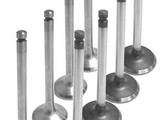Mini Spares/Mini Mania race-spec valves, the reasons why.
Covering valve part numbers-
| Inlets | C-AHT55 - 1.464"/37.2mm | Exhausts | C-AEG107 - 1.220"/31.0mm |
| C-AEG544 - 1.402"/35.6mm | C-AEG106 - 1.161"/29.5mm | ||
| C-AEG569 - 1.311"/33.3mm | C-AEG587 - 1.040"/26.4mm | ||
| C-AEG588 - 1.218"/30.9mm (small-bore) | (small-bore) |
Many moons ago, the standard performance valve shape was the then-ubiquitous 'penny-on-a-stick' profile. For the very good and simple reason it minimised airflow obstruction by having the least amount of material in the way. Very plausible, and a design that many have stayed with to this day - surprising considering the magnitude of expertise housed in the more recognized A-series tuners. Probably something along the lines of 'if it ain't broke, don't fix it', or perhaps (and more likely?) 'Can't teach an old dog new tricks'.
However, as time and technology progressed, man's ever-inquisitive nature started to determine more exactly what and why - and airflow activity was not passed over. Not only 'how much' was being measured, but 'where and how' to further determine where improvements could be made. After all - it has long since been realised that the engine is essentially an air pump. The more you get in, the more you get out, so improving the air's tortuous route to the cylinder has to help. A situation made particularly worse in the case of the A-series with its right-angled bend at the valve end. Air simply does not like flowing in anything other than straight lines. It has to be 'persuaded' round all restrictions.
To this end, it would seem prudent to carry out testing to see what could be done to help the venerable A-series to be more air-efficient. Surprisingly few have actually done this with any real 'method' of investigation. Actually, it's not so surprising when considering getting 'one off' sets of valves made is very costly and time consuming in this country. And the investment time costs big money - something that is extremely difficult to re-coup where our favourite tin box is concerned.
Cutting a very long story short - I did some testing of my own, using interesting ideas and applications picked up from dealing with the likes of Bob Griffith of BHP Developments, perhaps America's prime A-series tuner for many years. The opportunity to validate my findings came some years ago when the modern Mini Coopers were thrown in to battle once more in the world rally arena in Group A/n guise. This saw a resurgence of interest, and Mini Spares became involved with C.E.S. in squeezing the most out of the engine bearing in mind regulation limitations. Notably valve sizes - the plug in the hole of power production in most cases. I suggested what I thought would prove beneficial. After testing some half dozen different valve shapes for both inlet and exhaust on flow bench and dyno, C.E.S. confirmed my thoughts. The result is the current range of race-spec valves on offer.
The inlets have the usual waisted stem with a relatively flat back profile employing a 30-degree initial angle leading into the 45-degree valve seat. The exhausts were where things changed by using a back profile very similar to a standard valve. Without the immensely expensive facilities of universities to measure exactly why, I can only offer my speculation (agreed on by a number of top-slot tuners) that although the flat back valve principle is a reasonable one, it doesn't allow for air behavior. The more aerodynamic shape similar to the standard valve is likely to be reducing turbulence, hence increasing airflow. And on the flow bench this was proven.
A simple test was done by taking a race head produced by probably the most prolific A-series modified head producer and recognised 'name', flow testing it, then swapping it's 'as supplied with' valves with those sold by Mini Spares. The inlets were all but identical, varying by less than 0.1cfm at the very most. However, the exhausts were a different story -
| Flow with 'as supplied' valve | Flow with Mini Spares Valve | Flow achieved in Min-Tec head | |
| Valve lift | |||
| 0.050 | 20.7 | 20.9 | 22.4 |
| 0.100 | 38.3 | 38.6 | 42.2 |
| 0.150 | 52.5 | 53.1 | 64.7 |
| 0.200 | 62.7 | 63.6 | 76.6 |
| 0.250 | 70.6 | 71.7 | 83.6 |
| 0.300 | 78.1 | 79.0 | 90.5 |
| 0.350 | 83.6 | 84.9 | 97.0 |
| 0.400 | 88.9 | 90.3 | 102.0 |
| 0.450 | 93.0 | 94.6 | 103.0 |
| 0.500 | 96.8 | 98.4 | 105.0 |
| 0.550 | 99.5 | 101.1 | 105.1 |
The valve size used here was 31mm except the Min Tec head was 30.78mm, which was cut down from the Mini Spares 31mm valve. Even so, the result shows simply fitting the Mini Spares style exhaust valve improved flow compared to the flat-back type by around 1 to 1.6 % throughout. Not at all bad for a straight valve swop.
Material-wise, EN214N stainless steel is used throughout. Finish-wise all stainless steel valves are now Tuftrided to vastly improve their resilience to the savage nature of unleaded fuel. It also helps combat galling where normal running temperatures are exceeded or lubrication becomes a problem thus helping the valve train to fight another day when things go pear-shaped!
One other item of note - the Mini Spares valves are considerably cheaper than other more recognised brand names…








